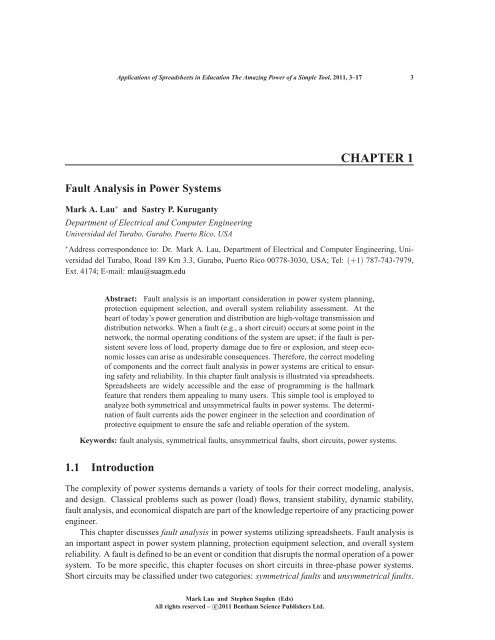chapter 3 - Bentham Science
chapter 3 - Bentham Science
chapter 3 - Bentham Science
Create successful ePaper yourself
Turn your PDF publications into a flip-book with our unique Google optimized e-Paper software.
Applications of Spreadsheets in Education The Amazing Power of a Simple Tool, 2011, 3–17 3<br />
Fault Analysis in Power Systems<br />
Mark A. Lau ∗ and Sastry P. Kuruganty<br />
Department of Electrical and Computer Engineering<br />
Universidad del Turabo, Gurabo, Puerto Rico, USA<br />
CHAPTER 1<br />
∗ Address correspondence to: Dr. Mark A. Lau, Department of Electrical and Computer Engineering, Universidad<br />
del Turabo, Road 189 Km 3.3, Gurabo, Puerto Rico 00778-3030, USA; Tel: (+1) 787-743-7979,<br />
Ext. 4174; E-mail: mlau@suagm.edu<br />
Abstract: Fault analysis is an important consideration in power system planning,<br />
protection equipment selection, and overall system reliability assessment. At the<br />
heart of today’s power generation and distribution are high-voltage transmission and<br />
distribution networks. When a fault (e.g., a short circuit) occurs at some point in the<br />
network, the normal operating conditions of the system are upset; if the fault is persistent<br />
severe loss of load, property damage due to fire or explosion, and steep economic<br />
losses can arise as undesirable consequences. Therefore, the correct modeling<br />
of components and the correct fault analysis in power systems are critical to ensuring<br />
safety and reliability. In this <strong>chapter</strong> fault analysis is illustrated via spreadsheets.<br />
Spreadsheets are widely accessible and the ease of programming is the hallmark<br />
feature that renders them appealing to many users. This simple tool is employed to<br />
analyze both symmetrical and unsymmetrical faults in power systems. The determination<br />
of fault currents aids the power engineer in the selection and coordination of<br />
protective equipment to ensure the safe and reliable operation of the system.<br />
Keywords: fault analysis, symmetrical faults, unsymmetrical faults, short circuits, power systems.<br />
1.1 Introduction<br />
The complexity of power systems demands a variety of tools for their correct modeling, analysis,<br />
and design. Classical problems such as power (load) flows, transient stability, dynamic stability,<br />
fault analysis, and economical dispatch are part of the knowledge repertoire of any practicing power<br />
engineer.<br />
This <strong>chapter</strong> discusses fault analysis in power systems utilizing spreadsheets. Fault analysis is<br />
an important aspect in power system planning, protection equipment selection, and overall system<br />
reliability. A fault is defined to be an event or condition that disrupts the normal operation of a power<br />
system. To be more specific, this <strong>chapter</strong> focuses on short circuits in three-phase power systems.<br />
Short circuits may be classified under two categories: symmetrical faults and unsymmetrical faults.<br />
Mark Lau and Stephen Sugden (Eds)<br />
All rights reserved – c○2011 <strong>Bentham</strong> <strong>Science</strong> Publishers Ltd.

















